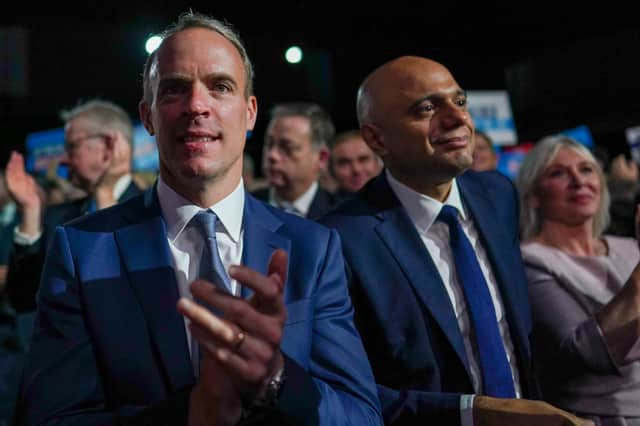MPs' pay: members who lose seat or stand down to see 'winding down' payments doubled to £17,300
and live on Freeview channel 276
MPs who lose their seat or stand down at the next general election will have their 'winding down' payments doubled to £17,300.
The financial support is designed to help departing MPs close their office, finish their casework and help with the departure of staff, who will also lose their jobs. For the first time it will now also be available to those who step down at the election.
Advertisement
Hide AdAdvertisement
Hide AdMPs received two months’ wages after losing their seats at the previous general election, but the Independent Parliamentary Standards Authority (IPSA) – which governs MPs’ expenses – has ruled that should be increased to four months.
How much are MPs' winding down payments?
As MPs have an annual salary of £86,584, it will mean the payment rise from roughly £8,600 to £17,300. With more than 70 standing down at the next election - including more than 40 Tories - that will mean taxpayers will be forking out more than £1million, not including the MPs losing their seats.
The payments will not be given to MPs leaving outside of an election, meaning people like Tory former Prime Minister Boris Johnson, who resigned in June, will not be eligible.


IPSA said the decision was made because the time to fully close down an MP’s parliamentary and financial affairs is longer than the period covered.
Advertisement
Hide AdAdvertisement
Hide AdThe ruling said: “Former MPs will continue to have access to their normal budgets (pro-rated) for that four-month period, and they will continue to employ staff as needed to assist them in winding up their affairs.”
MPs who have served more than two years are also eligible for loss-of-office payments, with longer-serving MPs receiving larger amounts. The payments, similar to redundancy packages, will be available to all eligible MPs who leave Parliament at the next election.


'Kick in the teeth for taxpayers'
John O’Connell, chief executive of the TaxPayers’ Alliance, criticised the move, saying: “Doubling golden goodbyes for MPs is a kick in the teeth for taxpayers.
“Hard-pressed Brits are already funding generous salaries, perks and pensions for elected officials. IPSA should be mindful of that when recommending more taxpayers’ money for politicians.”
Advertisement
Hide AdAdvertisement
Hide AdHowever former staffers told NationalWorld that most of the payments will be going towards staff members being made redundant, paying off costs involved with closing up constituency offices and handing over casework.
Chair of the GMB Union MPs' staff branch, Jenny Symonds, said: "This is not money into MPs’ back pockets. This is a practical budgetary increase to make election transitions more efficient.
"Winding up an MPs’ office is hard work, trust me, and this extra support will make that task a lot easier. Helps staff, helps constituents, simple as."
The MPs standing at the next election include Tory former cabinet ministers Dominic Raab, Matt Hancock and Sajid Javid, and the current Defence Secretary Ben Wallace.
Advertisement
Hide AdAdvertisement
Hide AdLabour former ministers Harriet Harman and Margaret Hodge have also said they plan to step down, as has the SNP’s former leader at Westminster Ian Blackford and select committee chairs Sir Bill Cash, William Wragg and Robin Walker.
'Shows us in a bad light'
Speaking on TalkTV, Tory MP Bob Seely (Isle of Wight) said: “I don’t think people resigning should be getting a payout.
“But this is an independent body, I’m afraid to say we don’t get to vote on it unless somebody tells us that we do, and frankly, I am more concerned about dealing with my constituency casework.
“So I’m not particularly happy about this either because it just shows us in a bad light and despite the fact it’s an independent body, everyone is going to blame us for it. It really winds me up, frankly.”
How much do MPs earn - and have they had an above-inflation pay rise?
Advertisement
Hide AdAdvertisement
Hide AdMPs have seen their pay packets swell by over £20,000 over the last 14 years, with the rise this April representing a 31.7% cash terms increase compared to 2010/11 levels, when they earned £65,738. After adjusting for inflation, however, MPs actually experienced a real-terms pay cut of 0.6% between 2010/11 and 2021/22. This is based on the Consumer Prices Index (CPI) measure of inflation published by the Office for National Statistics (ONS).
If their wages had kept pace with inflation, MPs would have seen their pay rise to £82,415 in 2021/22. Instead, it rose to £81,932. Inflation data is not yet complete for 2022/23, but with the average standing at 9.1% for the year so far (April to December), the newly announced pay rise for MPs will clearly fall far below inflation this year.
Loading....
MPs may also receive other parliamentary income, depending on the level of responsibilities they have. Besides the basic salary, IPSA is also responsible for setting the level of compensation that parliamentarians receive for chairing select committees, or being part of the panel of chairs (who chair public bill committees). Both of these components will be going up by 2.9% in April, to £17,354 apiece.
How much do public sector workers earn?
Since 2015, IPSA has pegged MPs’ pay to changes in the average salaries for public sector workers, as measured by the ONS. Its decision to award a 2.9% cash terms pay rise this year reflected the average rate of wage growth for public sector employees in the three months to October 2022, compared to October 2021.
Advertisement
Hide AdAdvertisement
Hide AdIn 2021/22, full-time public sector workers earned an average of £35,259, according to the ONS – less than half of what MPs earned. Between 2010/11 and then, public sector salaries rose by 23% in cash terms (compared to 24.6% for MPs) – but fell by 1.9% after adjusting for inflation, a worse pay cut than that suffered by MPs.
Loading....
Have wages in your industry kept pace with MP salaries?
NationalWorld has built an interactive chart that allows you to look up different job roles to compare whether wages have kept pace with MP salaries since 2010/11. This chart uses data from the ONS, which measures the median annual salary of full-time employees across the UK.
Loading....
Not every job has a comprehensive record of average salaries – some may have gaps in the timeseries when not enough data could be gathered by the ONS to make the estimates reliable. Some jobs have been excluded from our chart as a result.
If your specific job title is not included, you may be able to search a broader category – either the sub-category (for instance ‘nursing professionals’) or a master category (such as ‘health professionals’) to compare salaries among these groups of employees. The searchable table below will help you find what sub-category or master category your job belongs to. Can’t see the chart? You can view it on the Flourish website here.
Loading....
Advertisement
Hide AdAdvertisement
Hide AdIf you cannot find your job in the chart, put a key word into the searchable table, to find out what specific job title is listed in the ONS data.
For instance, if you search ‘decorator’ you will find the ONS publishes salary data for the job cluster ‘painters and decorators’, which you can find grouped under ‘P’ in the chart’s drop down menu.
You can also search for an industry, such as ‘natural and social science professionals’, or the nature of a job, such as ‘chief executives and senior officials’, to see all the job titles grouped under them. Can’t see the table? You can view it on the Flourish website here.
Comment Guidelines
National World encourages reader discussion on our stories. User feedback, insights and back-and-forth exchanges add a rich layer of context to reporting. Please review our Community Guidelines before commenting.